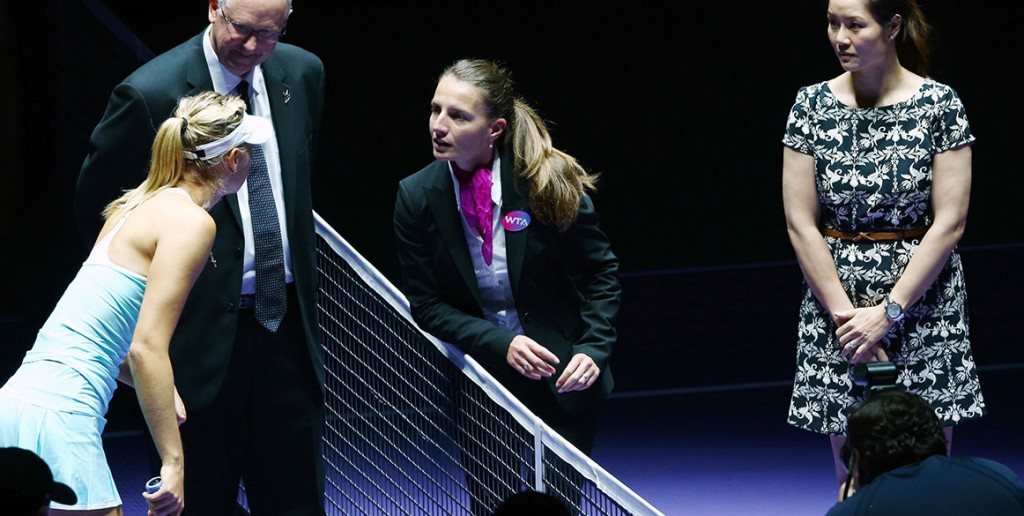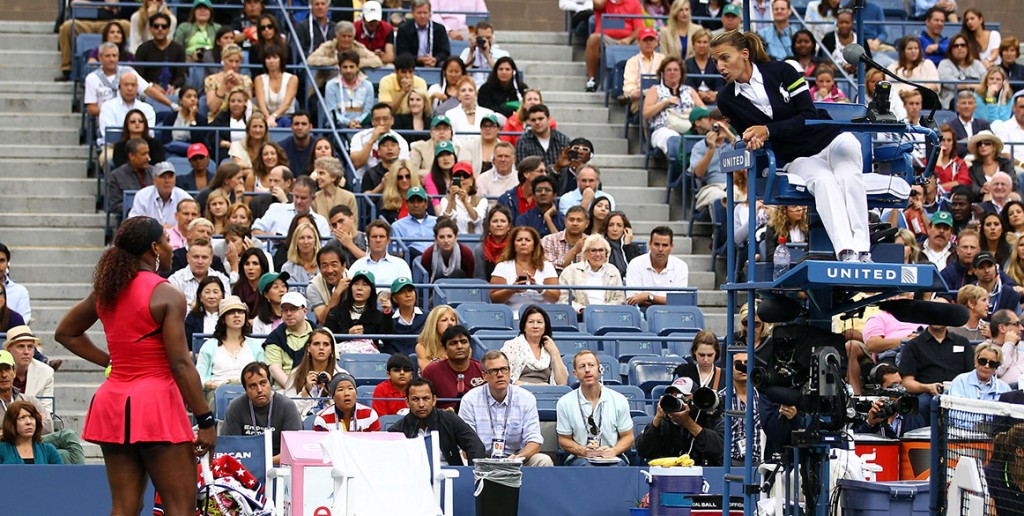Eva Asderaki-Moore had long been a highly-regarded international chair umpire, yet shot to prominence in 2015 when she became the first female to ever sit in the chair for a US Open men’s singles final.
The Greek-born, Melbourne-based Asderaki-Moore is one of 29 gold badge umpires in the world, the highest level of international certification for tennis umpires and a status she achieved in 2007. After several years as a WTA umpire, she began working as an ITF umpire from January 2016.
Tennismash caught up with her recently when she was in Melbourne to oversee Australian umpires in the process of officiating claycourt matches.
On the rigours of international travel:
“It has been like that (25-30 weeks on the road each year), but I’m cutting down. A lot, which is very good … it’s not easy for your body, and it’s not easy if you have family and for your personal life. I’m glad I can cut down, but obviously still work full time. You go there, you have jet lag, you have different weather conditions, every week almost … (Working ITF now) that will mean I will be going to the Grand Slams and I will be doing Davis Cup and Fed Cup ties, and the Olympic Games. As part of my contract, that’s it. Potentially go and teach a couple of schools. I can still do a couple of WTA events if I want to, but I haven’t decided yet. (This year’s schedule) is a bit lighter.”
On being a gold badge umpire:
“You can do finals on the tours. You can umpire Grand Slam finals, Davis Cup and Fed Cup finals, everything … it was amazing (to reach this level), it was a great feeling. It took some time. After I got my bronze badge, it took about four years before I got my silver, for a lot of reasons. And then when I finally got my silver (badge) and then got my gold, it was a great feeling.”
On how she got into umpiring:
“I used to play tennis as a junior in Greece at my hometown, Chalkida, which is about one hour from Athens. One week in March 1997 we had an international tournament at my tennis club and I volunteered as a line umpire. I was 16, and I loved it. I liked being on court doing something else and I met some other umpires who came from other countries, They were telling me their travelling stories and all that, so at 16 I was like, ‘I want to do that!’ (laughter). And that’s how I started. At that time in Greece I was fortunate – when I started there were only three more chair umpires, at a low level, and they needed more people. So they put me into the chair in small tournaments – Futures and Satellites – but they put me up to do chairs from the beginning. Which I think was great because I was very young and I was doing chairs for men and women without line umpires or maybe with one line umpire, because at these (lower level) tournaments you don’t have the full crew … As a chair umpire, that’s where you really learn. You must be able to see the ball, because you’re on your own. That was great for me, great experience.”
On how much leeway umpires have to interpret the rules when the call is not black and white, such as in or out:
“There are so many different scenarios that potentially can happen. Even if there is a rule about it, it can be interpreted in many different ways, and that’s when we say: yes, we know the rules, but we need to be able to apply a little bit of common sense as well. Simple example – a player smashes a racquet. Is it an automatic code, or is it not? It depends. It depends on how hard it is (smashed), it depends on potentially what stage of the match it is. Sometimes you want to let them be able to let some steam out. So as long as it’s nothing too aggressive or as long as the racquet is not completely destroyed, you’ll see that some umpires won’t do anything; they just potentially speak to the player on the next changeover to just remind them: look, OK, you did that and I understand why, but now, calm down. You’ll find some umpires who don’t do anything and just prefer to talk to the players, and you will see others who, just because (the player) did it, they believe it should be a code (violation), so they give it. These cases are cases where you think: OK, this is the rule, so what do I do now? It’s all about match control as well – we don’t want to be policemen either, but of course there are limits, and the players need to play within those limits. So it’s about finding this balance.
“I think at the beginning when you start (as an umpire), you have all the rules and you think: I need to make every call right and I need to apply the correct rule every time. You’re a little bit keener to say: that’s the rule and I’m going to go with it (strictly). But with experience and potentially knowing the players, and having watched other umpires and how they deal with different situations, I think that’s when you say: OK, I can take a step back and manage the situation in a bit of a different way.”
On why there are sometimes disagreements between players and chair umpires about ball marks on clay courts:
“If you imagine a clay court, think of the baseline where the players are running all the time. The clay will not be nice and smooth. There will be footprints, there will be loads of other marks. And then you have a ball that has landed among all those things and has not left a perfect mark. You go there, and you need to be able to think: was that a lob? Was that a crosscourt shot? Was that a winner down the line? And be able to imagine what mark that shot would have left. And then be able to say: is it symmetrical? Is it all outside the line or would there be a part of it on the line? That’s when these discussions (between the umpire and the player) come.”
On the introduction of Hawkeye:
“At the beginning it was: ‘Oof. Now let’s see what’s gonna show’ (laughter). But now it’s great. It’s definitely a help because at the end of the day it doesn’t matter if it shows the same as what we called or not. For the players, they challenge, they see they are right or wrong and then they go back and play. Whereas before they would, if they thought we (the umpires) were wrong, they would argue more. So it has taken that out a little bit, which I think is great. It would stay in their mind, potentially for the rest of the match … If we can have something that will help to get the right result, then why not use it? (If players challenge an umpire’s overrule) there is a moment where you think: ‘OK, show it out, show it out, please show it out’ (laughter). But you need to have a poker face and be like: ‘OK, fine’.”

Eva Asderaki-Moore (centre) speaks to Maria Sharapova (L) ahead of Sharapova’s match against Agnieszka Radwanska at the 2015 WTA Finals in Singapore; Getty Images
On how well she knows the players, and what the relationship is like:
“What I mean when I say I know the players well, is that I know their on-court behaviours well. We cannot really socialise with the players. Of course we see them week in and week out, so yes, with some of them we’re going to have a bit of a chat, but that’s it. There is a limit, because it’s conflict of interest at the end of the day. You cannot really be friendly with somebody and then go and umpire their match. It’s all about perception. But on court, obviously we know them quite well (laughter). That helps to know how strict or how lenient you can be with them.”
On what it’s like to have to discipline a player:
“I wouldn’t say it’s intimidating, but obviously it’s not a pleasant situation to be in. When you have someone who’s constantly doing something, you constantly need to be on top and talk or do or take action. But at the end of the day you have to do what you have to do. You know that 90 per cent of the time you’re not going to have both players happy because that’s the nature of it, but you need to do your job. And they know you’re there to do what you’re doing.”

Eva Asderaki-Moore (R) docks Serena Williams a point penalty for intentional hinderance during Williams’ 2011 US Open women’s singles final match against Sam Stosur; Getty Images
On staying composed and focused during big matches with raucous crowds:
“I feel a little bit nervous going into the match and just at the beginning, because it’s a big deal. A final, is massive. But every match at the end of the day, for the players, is important. And you never know what could happen, even if you’re on Court 25, something unusual could happen and you need to be able to deal with it … but then you have the warm-up, which is a little bit of a warm-up for you as well to get familiar with the players, surrounding, crowds, day, night, all that sort of stuff. After that you just get in the zone. I try to make sure I don’t go (into the match) with an empty stomach. I have enough to drink but not too much so that I don’t have to run to the bathroom (laughter). I have my routine; I go and put my hair up in a ponytail and that’s when I get into thinking: OK, now it’s game on, we’re getting ready. Of course you are aware of the crowds, the noise, the lights, everything. But it’s kind of outside – you’re aware of it, but you don’t let it affect you.”
Stay tuned for the second part of our interview with Eva Asderaki-Moore, during which she discusses what it’s like to work with male players compared to female players, what rules in tennis she would like to see changed, and chairing that US Open final between Novak Djokovic and Roger Federer.
7 November 2016
Double Wimbledon champion, double Olympic champion and now world No.1. But what doesn't An... More
23 March 2017
Think umpiring is an easy job? Think again. Because umpire's don't just have to keep an ey... More
24 February 2017
It is no coincidence that some of the best singles players to ever pick up a racquet all h... More
24 May 2016
With all eyes on the red clay of Roland Garros, there's plenty that club players can do to... More